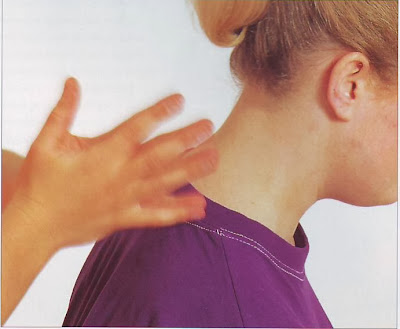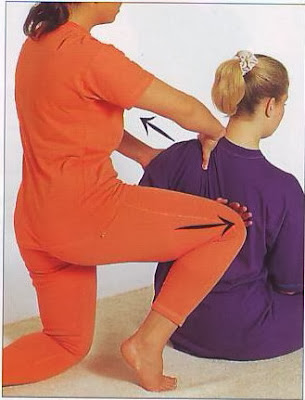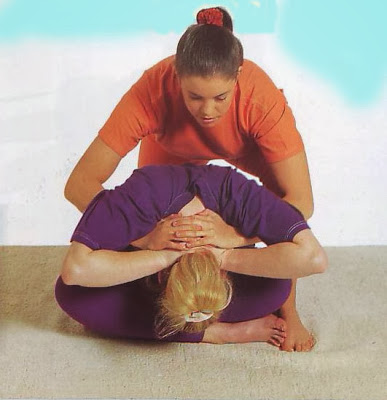Blockages to the
flow of energy between the trunk and the head, such as headaches, are released
by the techniques used in this part of the bodywork routine. In addition, tense
necks and shoulders are relaxed by pressing and stretching techniques. Some of
the techniques are good for treating ‘frozen shoulders’ and others manipulate
the spine. Refer to Chapter Two for the basic pressing and manipulation
techniques. The Sen energy channels shown here represent the upper sections of
the Chinese Bladder and Gallbladder meridians respectively. These Sen should be
pressed when treating the neck and shoulders in a sitting position.
Sen channels on the neck and shoulders
 |
ABOVE: The Sen channels on the neck and shoulders are: k - Chinese Bladder meridian and l - the Chinese Gallbladder merdian.
|
l k - Starts just below
the base of the skull one finger-width to the side of the midline and passes
down either side of the spine between the scapulae.
l l - Starts on either
side of the spine in the large depressions immediately below the base of the
skull and continues down the top of the
shoulders between cervical vertebra 7 and the back corner of the
shoulder joint.
l l - Starts on the
outer little finger, passes up the back of the armpit to below the outer end of
the shoulder, zigzags over the scapula spine and runs up the side of the neck.
1. PRESSING THE SHOULDERS
Touch Method One: Palmar
Pressing With your palms placed over the top of your partner’s
shoulders on either side of her neck, press progressively down her shoulders
using the heels of your hands. Pressing should be slow and sustained for up to
thirty seconds. Gradually increase the pressure by leaning into the presses.
Touch Method Two: Thumb
Pressing Thumb press along the tops of your partner’s shoulders along
the upper scapula and on the soft tissue on either side of the spine. As you
press, feel for any areas of knotted tissue.
- Energy flow through the
shoulder region is greatly improved which relaxes the neck. Headaches, as well
as pre-menstrual tension and pain in the shoulder region, can be eased.
2. ROLLING THE SHOULDERS WITH
THE FOREARMS
Place your forearms on top of your partner’s shoulders so
that they are positioned directly against her neck and, using your body weight,
roll your forearms outwards. Move progressively down to the outer margin of the
shoulders.
- This technique reinforces
all the benefits of the previous exercise.

- 1. PRESSING THE SHOULDERS
Pressed: Trapezius, levator
scapulae, erector spinae, rhomboideus major and minor
- 2. ROLLING THE SHOULDERS WITH THE
FOREARMS
Pressed: Trapezius, levator
scapulae, erector spinae
3. THUMB PRESSING THE NECK
Support your partner’s forehead lightly with one hand while
using the other to thumb and finger press the muscles on either side of her
spine. Use squeezing action. Work from the base of the neck up to the region
just below the skull. Swap hands to treat the other side. Repeat at least four
times.
6. BACKWARD ARM LEVER
Take your partner’s left arm, flex it at the elbow and raise
it in a backwards direction, placing her hand on her left shoulder. Use your
right hand to hold it in position while your left hand pulls her elbow
backwards. When you feel some resistance to movement, hold that position for a
few seconds and then release. Repeat on the other side.

- Opens the joint between the
scapula and clavicle. Good for easing frozen shoulder.

- 3. THUMB PRESSING THE NECK
Pressed: Trapezius, splenius
capitis
- 4. INTERLOCKED HAND/NECK PRESS
Pressed: Erector spinae, levator
scapulae, splenius capitis
- 5. STRETCHING THE NECK & SHOULDERS
Stretched: Sternocleidomastoid
Stretched: Pectoralis major,
triceps, latissimus dorsi, teres major & minor, subscapularis
7. ELBOW PIVOT LEVER
Raise your partner’s left arm and interlock the fingers of
your right hand with her left. Place the flat of your elbow very carefully on
the trapezius muscle on top of her shoulder. Lean in with your body weight. Use
this as a pivot as you lift her elbow backwards with your other hand. Hold for
ten seconds. Repeat on other arm.

- Aids shoulder mobility and
eases neck pain.
Do not use this pressure on
frail or bony subjects.
8. TWO-HANDED HACKING ON THE
SHOULDERS
Place both your hands lightly together with your fingers
spread apart and touching at their tips. Hack across the muscled areas of your
partner’s shoulders and between her shoulder blades.

- Hacking has a soothing
effect, leaving the shoulders and upper back feeling very relaxed.
9. THUMBING THE SHOULDERS WITH
ARM LOCK
Place your partner’s left arm behind her back and hold her
hand in position with your right knee. Thumb press up and down the muscled area
along the inner border of the shoulder blade. Use your left hand to draw her
shoulder back with each thumb press. Repeat on the other arm.

- Eases neck and shoulder
stiffness and pain.
10. SEATED LATERAL ARM LEVER
Kneel with your left knee resting lightly across your
partner’s thigh. Place her left palm against the side of her head and grasp her
elbow. Let her other arm rest across your thigh and grasp her right shoulder so
that it is well supported. Now push her left elbow to create strong lateral
flexion of the neck and trunk towards the right side. Hold for a few seconds
and then repeat this technique on the other side.

- Improves lateral
flexibility of the spinae and eases neck pain and tension. Effectively
stretches the muscles down the side of the trunk.
Stretched: Pectoralis major,
latissimus dorsi, subscapularis, teres major & minor, deltoid, triceps,
infra- & supraspinatus
Pressed: Trapezius
- 8. TWO-HANDED HACKING ON THE SHOULDERS
Pressed: Trapezius
- 9. THUMBING THE SHOULDERS WITH ARM LOCK
Stretched: Infra- &
supraspinatus
- 10. SEATED LATERAL ARM LEVER
Stretched: Sternocleidomastoid,
trapezius, levator scapulae, teres major & minor, erector spinae,
subscapularis, quadratus lumborum, latissimus dorsi
11. SITTING SPINAL TWIST
Using her left arm for support, your partner sits with her
left leg across her right. Use your left foot to lightly hold her left foot in
place. Simultaneously pull her right arm and push her left knee to generate a
good spinal twist. Repeat on the other side.

- Imposes a strong twist on
the back, improving spinal mobility and easing lower back pain.
12. PRESSING HEAD TO KNEES
Push your partner’s upper body slowly forward until a point
of strong resistance is felt. Flexible subjects will be able to touch their
knees with their head. Now palm press and pummel on either side of her spine.
You can repeat this technique with your partner in the cross-legged position.

- Improves forward
flexibility of spine, invigorates internal organs.
13. BUTTERFLY SHOULDER STRETCH
Ask your partner to clasp her hands behind her neck. Place
your forearms against the front of hers and then draw them slightly upwards and
backwards to create a strong shoulder stretch. Hold for several seconds as far
as is comfortable without causing pain.

- Releases tension in the
shoulder muscles and applies a small amount of traction to the upper spine. The
clavicular joints
14. BUTTERFLY MANIPULATION
Touch Method One:
With your partner’s hands clasped behind her head, tuck your hands under her
upper arms and grasp over her hands. Press to guide her into a forward bend in
the mid-line. Hold the position for a few seconds. Repeat several times.
Touch Method Two:
Repeat as above but this time direct your partner’s head first towards one knee
and then to the other to give a spinal twist.

- Improves spinal mobility
and flexibility, and eases lower back and neck pain and tension.
Do not force your partner
beyond the point where resistance is felt. Some people are very stiff when
bending in this direction and a small degree of flexion is adequate.
 Stretched: Biceps, latissimus
dorsi, trapezius, rhomboideus, piriformis, tensor fasciae latae
Stretched: Biceps, latissimus
dorsi, trapezius, rhomboideus, piriformis, tensor fasciae latae
- 12. PRESSING HEAD TO KNEES
Stretched: Erector spinae
Pressed: Erector spinae
- 13. BUTTERFLY SHOULDER STRETCH
Stretched: Pectoralis major,
Latissimus dorsi, teres major & minor, infra- & supraspinatus, triceps,
deltoid, subscapularis
- 14. BUTTERFLY MANIPULATION
Stretched: Erector spinae (neck
& back), quadratus lumborum
15. BUTTERFLY SPINAL TWIST
MANIPULATION
Retain the same hold on your partner as in the previous
technique, but this time place your left knee on her left thigh to hold it in
place. Then turn her upper body carefully and slowly to the right to give a
powerful spinal twist. Take great care not to overstretch.

- Gives a twist to the spine
and eases lower back pain lateral to the main spinal muscles.
Do not force your partner
beyond the point where resistance is felt. Some people are very stiff when
twisting sideways and a small degree of flexion is adequate.
16. FEET TO BACK STRETCH
Sit behind your partner and grasp her wrists. Place your feet
on her back on either side of her spine with your toes level with the lower
tips of her shoulder blades. Pull on her arms and press with your feet to
create a strong backward shoulder stretch. You can take tiny alternating steps
down the back to the lumbar region.

- Opens the joints between
the clavicle and scapula, and also the clavicle and sternum. Energy flow in the
channels on either side of the spine is stimulated to ease stiffness and pain
in the lower back.
17. BUTTERFLY BACKWARD
MANIPULATION
Interlock your partner’s hands behind her neck, and slide
your hands under her armpits, placing your fingers against her forearms. Put
your knees against her back just below her shoulder blades and press them into
her back against a gentle resistance from your arms. Repeat several times,
moving your knees a little further each time.

- Eases upper back pain,
improves flexibility; also relieves tension in the shoulders.
18. CROSSED UPPER ARM BACK
MANIPULATION
Cross your partner’s arms in front and grasp her right elbow
with your left hand and her left one with your right hand. Place your knees
mid-back on either side of her spine. Pull her elbows until her arms are tight
across her chest. Press your knees against her very firmly. A cracking sound
may be heard. Repeat with your knees at different levels.

- Aligns the vertebrae and
eases shoulder tension.
Not to be done to the
elderly or those with a history of osteoporosis.

- 15. BUTTERFLY SPINAL TWIST MANIPULATION
Stretched: Erector spinae (neck
& back), quadratus lumborum, latissimus dorsi, pectoralis major
Stretched: Pectoralis major,
seratus anterior, rectus abdominis, biceps
Pressed: Erector spinae
- 17. BUTTERFLY BACKWARD MANIPULATION
Stretched: Pectoralis major,
infraspinatus, rectus abdominis
Pressed: Erector spinae
- 18. CROSSED UPPER ARM BACK MANIPULATION
Stretched:
Triceps, trapezius, rhomboideus, some erector spinae
Pressed: Erector spinae










































